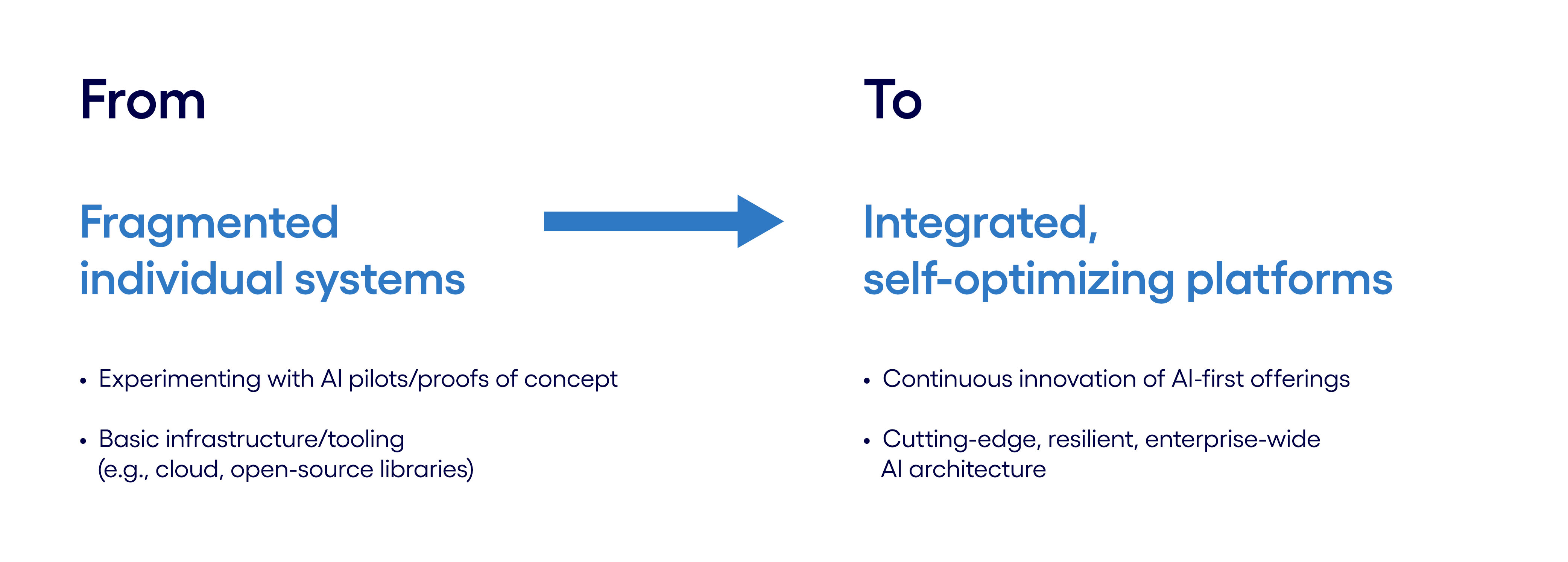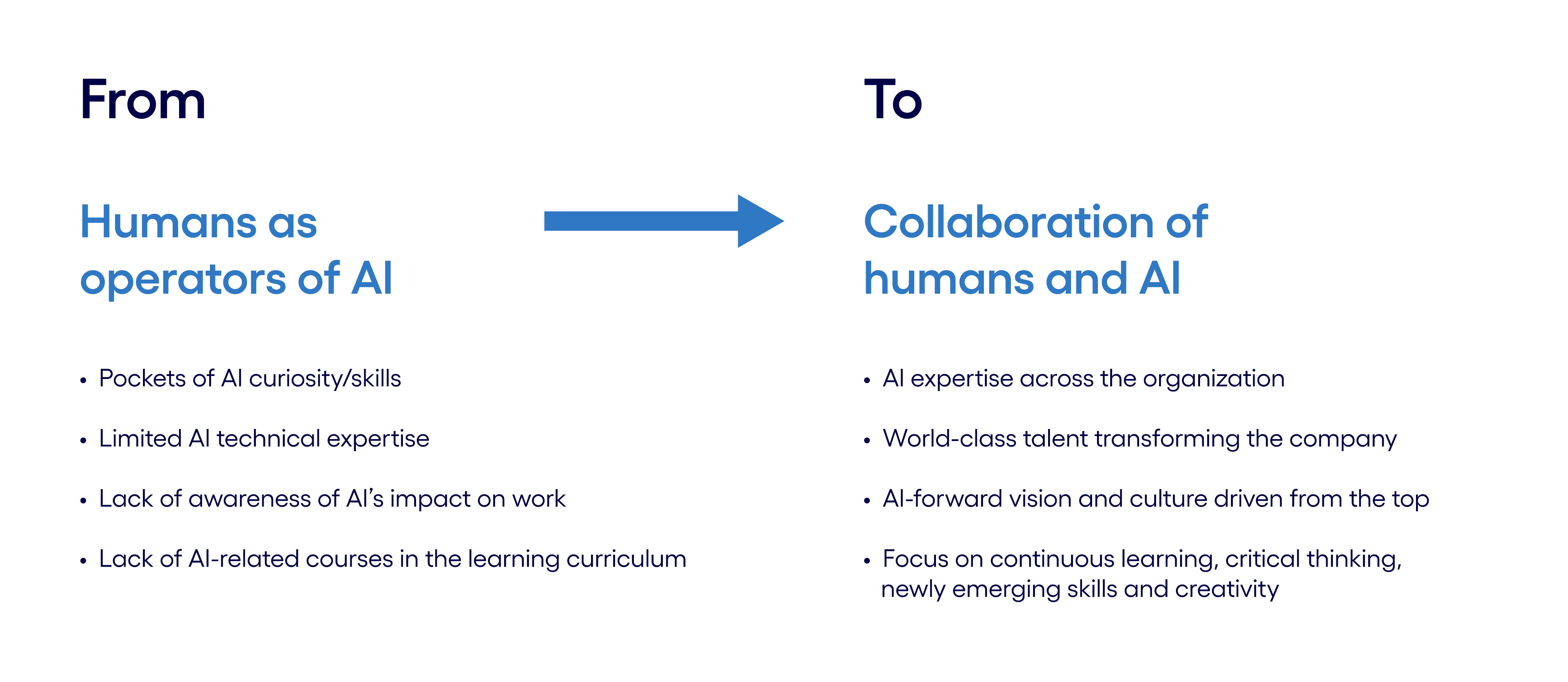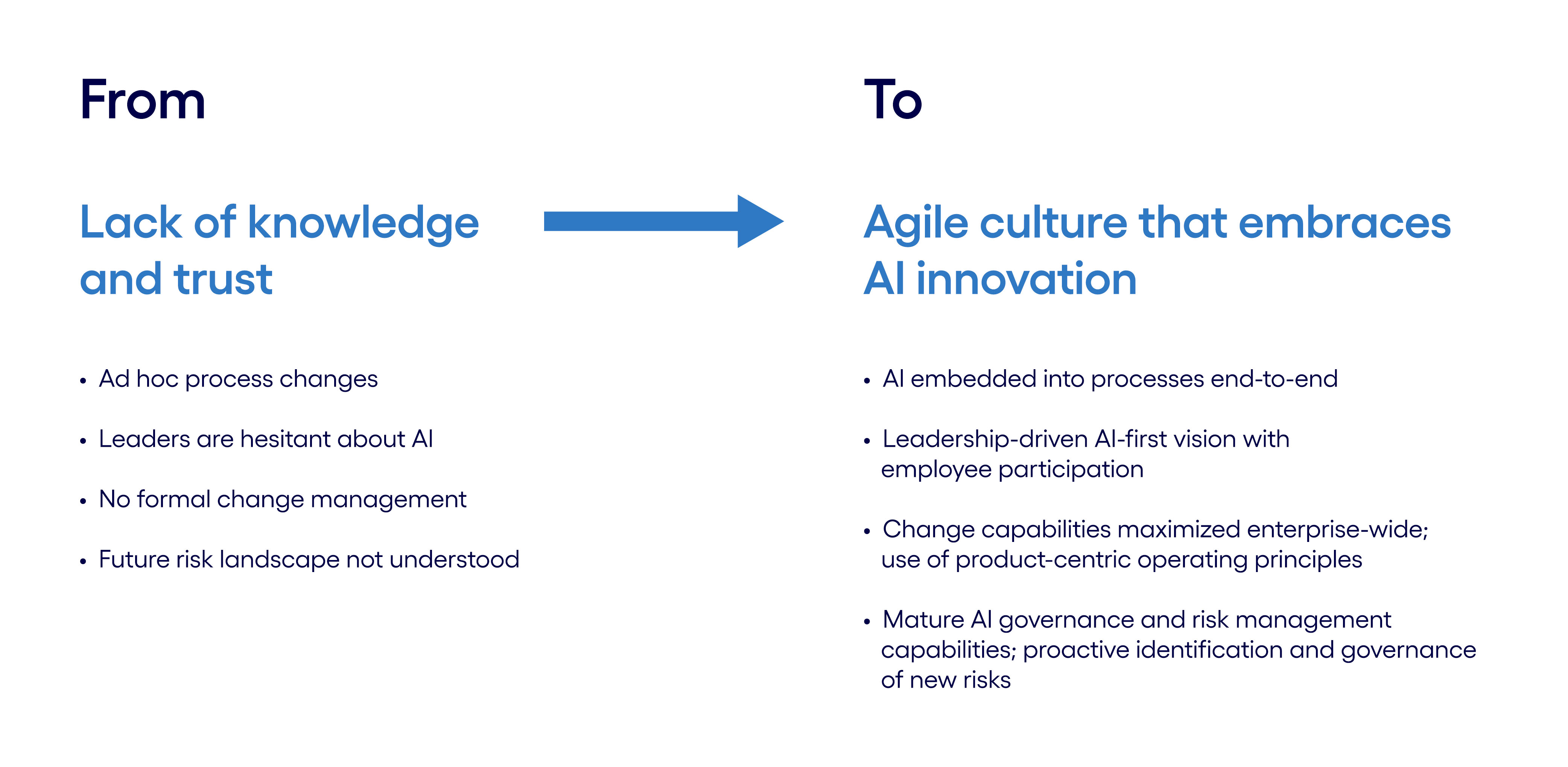April 26, 2024
The AI-powered future: A straightforward transformation approach
As the generative AI revolution progresses, the initial excitement has given way to the realities of integration and scaling. There is palpable pressure to act quickly—yet the myriad opportunities, fast technology evolution and significant complexity associated with implementing generative AI are causing businesses to get caught up in lengthy analyses as they try to determine where to place big bets.
Authors Mike Turner, Shveta Arora and Andreea Roberts believe leaders can get unstuck by moving quickly on four foundational levers of AI transformation, and by pondering one strategic question to guide big investments.
The AI landscape today is complex. Nevertheless, based on our work with hundreds of clients, the business world is experiencing a surge of generative AI pilots and proofs of concept in both back and front offices—speeding product design, sharpening procurement decisions, making suggested fixes to field services techs, or providing data and insights to customer service agents.
But how can companies advance from a series of disconnected experiments to a cohesive, change-the-business, change-the-game, strategic AI whole?
To cut through the complexity and advance with confidence, leaders must focus on two critical actions: They need to prioritize and fast-track the foundational shifts necessary for AI readiness, such as data modernization, workforce upskilling and agile governance, while scaling early gen AI success. Simultaneously, they should confront a pivotal strategic question that will guide their most significant AI investments and shape the course of their transformation journey.
AI-driven transformation: It’s different this time
Businesses that have navigated other big technology-driven changes—cloud computing, mobile technologies, automation, machine learning—might feel well-equipped to handle the business transformations that follow in the wake of technological disruption.
- It speeds up everything. Compared with previous digital initiatives that followed linear steps, generative AI algorithms supercharge the speed of change because they allow organizations to digitize and augment knowledge work like research, innovation, design and engineering.
A good example is the automation of ideation cycles. In the automotive industry, for example, generative AI can generate thousands of possible vehicle designs based on specified parameters, greatly reducing what used to be a five- to seven-year development cycle for new models.
Such exponential change requires new levels of organizational adaptability. In place of static multi-year plans, leaders need continuous, controlled experimentation built on reliable intelligence. By refining based on results, businesses can steer additional investments for success.
- Early adopters get the advantage. With other technology disruptions, companies could delay implementation and learn from pioneering adopters. Generative AI, however, makes it riskier for leaders to wait.
Some argue that in the face of rapid technology evolution, waiting may be wise in the case of AI as well. Yet, it is that same fast pace of evolution that also compels action. If new AI technologies evolve quickly, how does one decide when to jump in? How late is too late, and will the business suffer as competitors embrace these technologies sooner?
The first-mover advantage is especially visible in R&D, where use of generative AI could result in a significant competitive lead. In his book “Superintelligence: Paths, Dangers, Strategies,” philosopher Nick Bostrom discusses how the accelerated pace of advancement leads to scenarios where businesses attain a decisive strategic advantage. For example, a rival pharmaceutical firm could leverage biological data sets for rapid drug discovery and development. Similarly, in manufacturing, generative design can be paired with simulations and 3D printing for accelerated prototype iteration.
Companies able to compress innovation cycles in this way will capture significant first-mover benefits.
- Data modernization is non-negotiable. In the AI-first era, transforming underlying data foundations is the price of entry. Imagine an AI assistant trained on fragmented, incomplete data trying to hyper-personalize services in healthcare. The consequences would be catastrophic.
To compete in a future of “AI everywhere,” companies need to break down data silos and inconsistencies. Trusted data catalogs need to seamlessly integrate real-time and historical sources with transparency regarding provenance, assumptions and corrections made.
- The nature of work itself is changing. As personalized AI assistants and intuitive low-code platforms transform the shape of human-technology collaboration, many things will change dramatically: the nature of work, the relevance of certain skills and how work gets done.
To navigate this shift, enterprises will need to prioritize process and organizational redesign, skilling and change management. They’ll also need to put people first to contribute to a sustainable and equitable future with AI. Leaders who recognize AI's wide-ranging augmentation potential beyond just automation will proactively build cultures of learning, experimentation and trust.
AI maturity: the launch pad for an AI-enabled future
Given the current pace of technology evolution, “AI maturity” is really about how well the business is equipped to compete and thrive in a future where AI is incorporated into every process, system and job role. AI-led transformation is as much a mindset, modus operandi and culture shift as it is a physical retooling. Companies need to both insulate against new risks and be able to quickly seize new opportunities created by AI.
We outline below a series of moves businesses can make with confidence to advance toward preparedness on four key dimensions: data, technology, the workforce and change itself.
1. Get ready for the data economy
Figure 1
Data is the fundamental fuel for AI. To take full advantage of the next generation of AI and analytics, businesses have to modernize their data estates and evaluate opportunities to capitalize on data in a value ecosystem context.
To drive enterprise-wide AI, leaders need to:
- Establish a unified data platform. Break down data silos by implementing pipelines that move data from its originating source systems into an integrated data estate, whether on cloud or on-premises. To minimize reliance on manual efforts, businesses should use ETL (extract, transform, load)/ELT (extract, load, transform) tools to automate this aggregation and normalization process.
Once data is democratized in a unified environment, business users get simplified access at scale across domains instead of isolated data sets. It’s important to instill clear data governance policies and procedures to ensure data quality, security and compliance.
- Evaluate data in an ecosystem context and forge strategic partnerships. Assess the value of your organization's data assets not just within your own business context but also in the broader ecosystem of your industry and adjacent sectors.
Businesses should identify potential partners—suppliers, customers, research institutions, even competitors—that may have complementary data assets or capabilities and explore opportunities to combine their data with that of other ecosystem players to create new value propositions, products or services. By exploring strategic partnerships and collaborative frameworks, businesses can enable secure and governed data sharing and co-innovation.
2. Infuse agility into the tech stack
Figure 2
Businesses should think of AI components less as one-off projects and more as platforms. Doing so will accelerate the integration of intelligence into solutions. If enterprises focus on core enablers like software engineering and evolving their enterprise architecture to a modular design, they will be able to rapidly integrate new capabilities and leverage new technologies.
To prepare for the new speed and agility required to succeed, enterprises will depend on the flexibility and scalability of a modern, hyper-automated, cloud-native architecture:
- Accelerate the shift toward a cloud-native architecture. Migrate applications and workloads to a cloud-based infrastructure to leverage scalability, flexibility and cost-efficiency benefits.
- Modernize software engineering and build multi-experience platforms with APIs and microservices. This approach enables faster experimentation and composability to extend solutions with AI capabilities for customers and employees.
- Add machine learning operations (MLOps) and large language model operations (LLMOps) pipelines to automate model retraining and performance tracking. In effect, this industrializes AI management so it can scale across use cases without manual intervention.
- Provide self-service access to shared data, models and tools across the enterprise. Doing so will enable business technologists to rapidly prototype innovations without centralized dependencies. Democratization of tools will help unlock latent productivity.
3. Cultivate the workforce
Figure 3
Of all the changes along the journey of AI-led transformation, the changes related to people present some of the greatest unknowns.
As a team of researchers from MIT, Harvard and Wharton suggested last year, it will take seamless collaboration to unlock the greatest value from the human and AI partnership. When humans know when to engage AI, and when to rely on human knowledge and intuition, they realize much better outcomes compared with human-only or machine-only work.
Here are two concrete actions businesses can take to prepare employees for the next level of human-machine collaboration:
- Evolve learning curricula to educate domain experts on AI. Contextualize AI ethics training for customer- and domain-facing teams and enable employees to self-direct experiential learning around automation tools.
Educate employees on the key questions to ask, to understand AI reasoning and overall critical and practical thinking. Recurring refresher courses, similar to security and ethics training today, can ensure employees continue to scrutinize AI-generated results and apply common sense.
- Build and empower cross-functional AI acceleration teams. These are chartered squads combining business, design and technology perspectives to rapidly prove concepts that executives sponsor into production-ready solutions.
Employees need to learn how to best work with AI to augment their capabilities, and they need to be inspired to experiment and innovate. With these critical elements, businesses can turn employees into champions in the transformation journey.
4. Create conditions for the change to take place
Figure 4
To quickly drive change across the organization, businesses require ongoing change management that reflects the needs of a multi-generational workforce—especially when it comes to building trust, increasing agility and enabling a culture of innovation:
- Map a clear path for employee engagement. Proactively address employee concerns around job security and AI bias through transparent communication. Clearly outline reskilling plans and responsible AI governance measures to build confidence in the organization's approach.
- Embrace product-centric ways of working. Modernize the organization for agility and customer focus by shifting to a product-centric delivery model. This approach enables rapid experimentation, iterative learning and continuous improvement, allowing teams to quickly adapt to changing AI capabilities and customer demands.
As the evolution of AI continues at an unprecedented pace, the organizations that will thrive are those that can successfully navigate the human dimensions of the transformation. By building trust, fostering agility, investing in continuous upskilling and establishing strong AI governance and risk management practices, they can create a workforce that not only adapts to the AI revolution but also harnesses its full potential to drive innovation and growth.
Where to place big bets: One strategic choice
As leaders navigate this transformative journey, they will face critical forks in the road. Of all the decisions they’ll need to make, however, we believe there is one choice that will help crystalize their thinking about the purpose of using AI, and thus facilitate the decision on where to focus first.
Should leaders take the optimization path, leveraging AI to maximize productivity, building a distinctive knowledge core and subsequently delivering disruptive value propositions? Or rather, should they boldly pursue a disruptive challenger path, harnessing AI's power to create radically new products, services and business models?
The answers to these questions will act as a North Star, guiding investment decisions and illuminating the sequence of steps one must take to forge a path to AI-led transformation.
1. The optimization (or productivity-powered) path
We see this as the no-regrets path, and it’s also the route most traveled. The priority with this approach is to optimize the organization’s existing operations with generative AI, and then establish and leverage an industrialized change engine to build further productivity use cases quickly. Disruptive innovation is then evaluated and funded from the resulting efficiencies.
These initiatives are large in scale but executed incrementally. Organizations opting for this direction need to:
- Make the change delivery function as productive as possible
- Use savings to aggressively automate operations and remove productivity blockers within the technology function to create data and tech readiness for AI
- Implement next-gen AI in internal areas of proven revenue and margin impact, such as customer operations, sales and marketing, knowledge management and R&D
- Leverage further savings to upskill the workforce on role augmentation with generative AI
- Build a next-generation knowledge core that digitizes new forms of competitive domain knowledge, such as industry expertise
- Use the knowledge core to realize disruptive customer propositions
By pursuing this route, businesses can build a solid foundation for future disruption. They can take efficiency gains from automation and workforce augmentation and invest them in building next-generation data estates, knowledge systems and innovative customer offerings.
2. The disruptive challenger path
While the optimization route does not preclude businesses from leveraging generative AI, it does not fully exploit the disruptive potential of the technology until the later stages of implementation.
Disruptive AI uses cases cannot be built on top of current business without specialized knowledge and often do not make sense within the current cost structures of an established business. Therefore, for a certain segment of businesses, there is another option.
This choice is a “big-bet” approach, in which companies focus on creating entirely new, game-changing propositions from scratch, and enabling that proposition to grow outside of “the system.” IBM’s PC, Amazon Web Services, the Toyota Prius and Google’s AdSense were all developed in autonomous units that enabled focus and speed.
By incubating these initiatives in a separate, unconstrained environment, these trailblazers can nurture and scale their disruptive propositions without the limitations of legacy systems, processes or mindsets. As these pioneering ventures gain traction and prove their value, the rest of the organization can gradually pivot toward the new operating model, ensuring a smooth transition that maximizes the potential of generative AI.
Alternatively, some organizations may choose to maintain their disruptive AI ventures as separate entities, allowing them to operate with the agility and autonomy needed to stay at the forefront of innovation. This approach enables the core business to maintain stability and continuity while still reaping the benefits of its trailblazing offspring.
The steps for businesses choosing this direction are:
- Identify the features, data or knowledge core that enables the disruptive proposition
- Assemble an expert team in a self-contained “challenger” unit
- Build a radically disruptive customer proposition in a lab
- Launch and scale user adoption
- Fine-tune technology and operations for agility and efficiency
- Gradually transition the old business to the challenger, with a zero-base mindset
This is a higher-stakes strategy that requires an appetite for bold bets. However, for companies with the right assets and ambition, it presents an opportunity to create an enduring competitive advantage that others will struggle to replicate.
Whichever path you choose to take, Cognizant can help to jumpstart your journey and partner with you all the way to results. Our AI practitioners can assist across strategy, proof of concept, scale-up and refinement of AI solutions, while also ensuring AI use is sustainable at scale through domain data, hybrid models, platformization, automation and quality assurance.
The generative AI revolution presents businesses with an unprecedented opportunity to reshape their industries and redefine what's possible. But to fully harness this potential, leaders must navigate a complex and rapidly evolving landscape that can often feel overwhelming and paralyzing.
However, even in the face of such complexity, progress is possible. By prioritizing the foundational shifts necessary for AI readiness—such as next-gen software development, data modernization, workforce upskilling and R&D—and applying generative AI in areas with proven returns today, enterprises can optimize performance and achieve early success. Furthermore, recognizing and acting on opportunities to disrupt and create new value will position businesses for long-term growth and competitive advantage.
For more information on how to confidently transform for the future, visit our Rewire for AI page.
Latest posts
Related posts
Get actionable business Insights in your inbox
Sign up for the Cognizant newsletter to gain actionable AI advice and real-world business insights delivered to your inbox every month.
























